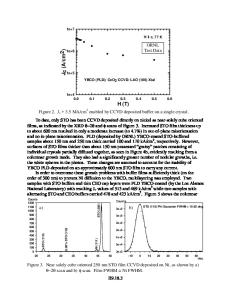Comparative fractography of chemical vapor and combustion deposited diamond films
- PDF / 23,386,158 Bytes
- 17 Pages / 593.28 x 841.68 pts Page_size
- 6 Downloads / 370 Views
I. INTRODUCTION
Diamond is a rare, naturally occurring material which has a unique combination of physical and chemical properties making it ideal for optical or electronic components and for coatings to reduce wear and corrosion. Polycrystalline diamond materials have been synthesized for decades using high-pressure, hightemperature methods. The recent low-pressure process of chemical vapor deposition (CVD) is more versatile, can be performed at lower temperatures, and has been developed for the rapid growth of polycrystalline diamond films.1'2 However, there is still a need to improve the diamond growth process to get higher deposition rates while retaining acceptable purity and crystalline quality. A much higher rate of deposition can be achieved at ambient atmosphere with an oxygenacetylene torch (combustion technique).3'4 In order for diamond films to be effectively used as components and especially as coatings, it is necessary to determine their strength and fracture characteristics. Generally, any polycrystalline, brittle ceramic with small grain misorientation, little cleavage tendency, and strong grain boundaries is expected to fracture transgranularly.5 With increased misorientation, higher cleavage tendency, and weak grain boundaries, an increase in intergranular fracture is expected. Strength measurements are available on a variety of polycrystalline diamond materials, both natural and synthetic sintered compacts.6 These materials, with a random orientation of grains, are of strength and hardness comparable to or greater than those of single crystal diamond. The harder materials exhibit transgranular fracture7'8 at room temperature with individual grains having a readily observable number of internal disloca2572
http://journals.cambridge.org
tions and twins.9 u Since these materials are randomly oriented and diamond has only a slight cleavage tendency, it is presumed that the grain boundary strengths are nearly equivalent to those of the internal grains. Diamond deposited as thick or thin films by CVD or combustion with random orientation and strong grain boundaries should be of comparable strength, and should exhibit transgranular fracture at room temperature. The size and shape of the CVD and combustion deposited films we have produced so far are too small for stress testing; however, by observing the fracture mode of these films at room temperature an indication of their strength can be obtained. Fractography has been assisted by using a scanning electron microscope (SEM) on surfaces produced by fracture of representative films of CVD and combustion type. Transmission electron microscopy (TEM) has been used to determine the nature of internal defects within grains both along the fracture surfaces and away from these surfaces for both of the film-growth processes. II. EXPERIMENTAL A. Deposition of diamond
Thin polycrystalline diamond films have been grown by the following techniques: filament assisted chemical vapor deposition (FACVD),12 microwaveassisted plasma enhanced chemical vapor deposition











